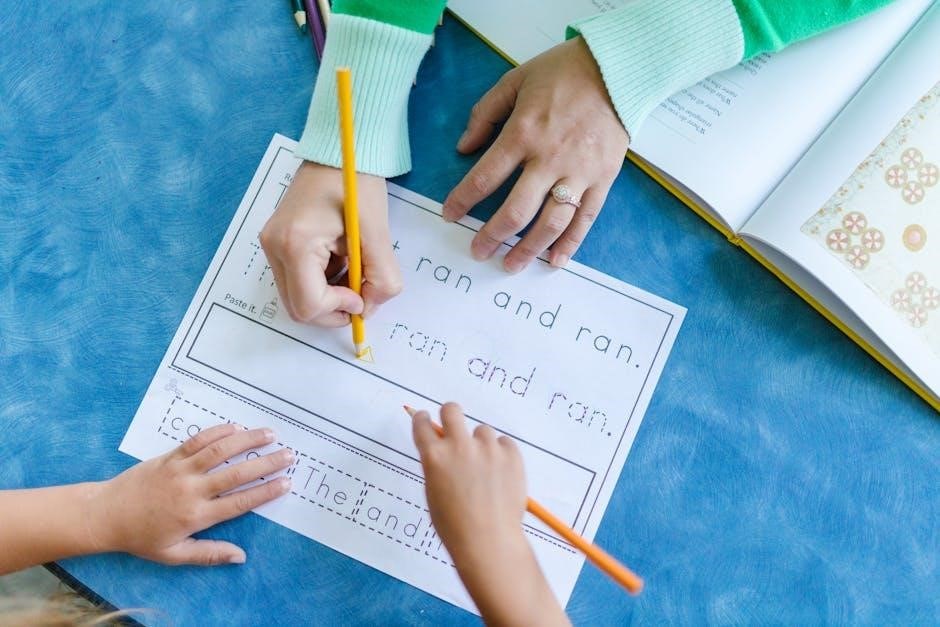Guided reading questions are instructional tools used by teachers to assess student understanding and promote critical thinking skills during reading sessions, utilizing various question types and formats effectively always.
Definition and Purpose of Guided Reading Questions
Guided reading questions are defined as instructional tools used to facilitate student comprehension and critical thinking during reading sessions. The primary purpose of these questions is to assess student understanding, promote engagement, and encourage active participation in the learning process. By using guided reading questions, teachers can help students develop a deeper understanding of the material, identify areas of difficulty, and provide targeted support. Effective guided reading questions are designed to be open-ended, allowing students to think critically and respond thoughtfully. They can be used in various formats, including interactive reading guides, comprehension question palm cards, and scoring criteria. The ultimate goal of guided reading questions is to enhance student learning outcomes, improve reading proficiency, and foster a love of reading. By incorporating guided reading questions into their instructional practice, teachers can create a more engaging and supportive learning environment. Guided reading questions are essential for student success.
Importance of Guided Reading Questions in the Classroom
Guided reading questions play a vital role in the classroom, as they help to create a supportive and interactive learning environment. By using guided reading questions, teachers can differentiate instruction, meeting the diverse needs of their students. These questions also help to build student confidence, as they provide opportunities for students to share their thoughts and ideas. Additionally, guided reading questions promote collaborative learning, encouraging students to work together and engage in meaningful discussions. The use of guided reading questions in the classroom can also help to improve student engagement, motivation, and overall academic achievement. Effective implementation of guided reading questions can lead to a more student-centered and inclusive classroom, where students feel valued and supported. By incorporating guided reading questions into their teaching practice, educators can create a more dynamic and effective learning environment that fosters academic success and a love of learning. Guided reading questions are a valuable tool for teachers.

Planning Guided Reading Sessions
Teachers plan guided reading sessions carefully, considering student needs and abilities, to create effective learning experiences always using various strategies and techniques effectively.
Preparing Guided Reading Questions
Preparing guided reading questions is a crucial step in creating an effective guided reading session. Teachers should consider the learning objectives and the needs of their students when preparing these questions. A variety of question types should be used, including open-ended and closed-ended questions, to assess student understanding and promote critical thinking skills. The questions should be clear and concise, and aligned with the learning objectives. Teachers can use various resources, such as textbooks and online materials, to prepare guided reading questions. Additionally, they can use question stems and frames to help guide their preparation. By carefully preparing guided reading questions, teachers can ensure that their students are engaged and motivated during the guided reading session, and that they are assessing student understanding effectively. This preparation is essential to creating a successful guided reading experience. Effective preparation enhances student learning outcomes.
Considering Student Needs and Abilities
When planning guided reading sessions, it is essential to consider the diverse needs and abilities of students. Teachers should assess the reading levels, learning styles, and prior knowledge of their students to create an inclusive and supportive learning environment. By doing so, teachers can tailor their guided reading questions to meet the unique needs of each student, ensuring that all students are challenged and engaged. This may involve using simplified language or providing additional support for struggling readers, or offering more complex questions for advanced readers. Teachers can also use technology and multimedia resources to cater to different learning styles and abilities. By considering student needs and abilities, teachers can create a guided reading experience that is accessible and effective for all students, regardless of their background or ability. This approach helps to promote student confidence and motivation, leading to improved learning outcomes; Effective consideration enhances learning.

Strategies for Implementing Guided Reading Questions
Teachers use various strategies to implement guided reading questions effectively always in classrooms daily.
Using Interactive Reading Guides
Interactive reading guides are a valuable tool for implementing guided reading questions in the classroom. These guides provide a structured approach to reading comprehension, allowing students to engage with the text in a meaningful way. By using interactive reading guides, teachers can vary the difficulty of questions and tailor them to meet the needs of their students. For example, a middle school teacher might use an interactive reading guide with her science class to prompt students to make connections between the text and their prior knowledge. The guide can include a range of question types, from simple recall questions to more complex critical thinking questions. This approach helps to promote active reading and encourages students to think deeply about the text. Additionally, interactive reading guides can be adapted for use with elementary students, using simpler language and questions to support their developing reading skills.
Encouraging Student Participation and Engagement

To encourage student participation and engagement, teachers can use guided reading questions to prompt discussions and interactions among students. This can be achieved by asking open-ended questions that encourage students to share their thoughts and opinions. For instance, a teacher might ask students to discuss a particular character’s motivations or to describe the main events in a story. By doing so, students are encouraged to think critically and make connections between the text and their own experiences. Teachers can also use strategies such as think-pair-share or small group discussions to facilitate student participation and engagement. Additionally, providing opportunities for students to ask their own questions and explore their own interests can help to increase motivation and engagement. By creating a supportive and interactive learning environment, teachers can help students develop a deeper understanding of the text and a love of reading. Effective implementation is key.

Assessing Student Responses to Guided Reading Questions
Evaluating student responses to guided reading questions helps teachers assess understanding and identify areas needing improvement always effectively online.
Establishing Consistent Scoring Criteria
To ensure fairness and accuracy in assessing student responses to guided reading questions, it is essential to establish consistent scoring criteria. This involves determining what aspects of the response will be evaluated, such as comprehension, critical thinking, and communication skills. Teachers can develop a scoring rubric that outlines the criteria and standards for each aspect, allowing for a systematic and objective evaluation of student responses. By using a consistent scoring criteria, teachers can compare student performance over time and identify areas where students need additional support. This approach also helps to reduce bias and ensures that all students are held to the same standards, promoting a fair and inclusive assessment process. Effective scoring criteria can be developed by collaborating with other teachers and reviewing examples of student responses to guided reading questions.
Providing Feedback and Support
Providing feedback and support to students is a crucial aspect of guided reading questions, as it helps students to understand their strengths and weaknesses. Teachers can use various strategies to! provide feedback, such as verbal comments, written notes, or peer review. The goal is to provide specific, timely, and constructive feedback that guides students towards improvement. Support can also be offered through additional instruction, scaffolding, or remediation, depending on the needs of the students. By providing feedback and support, teachers can help students to develop a growth mindset, build confidence, and take ownership of their learning. This, in turn, can lead to improved academic performance and a deeper understanding of the material. Effective feedback and support can be tailored to meet the diverse needs of students, promoting a supportive and inclusive learning environment that fosters academic success and personal growth for all students.
Guided reading questions conclude with effective implementation and assessment, enhancing student learning and understanding always successfully online.
Effective Use of Guided Reading Questions
The effective use of guided reading questions is crucial in enhancing student learning and understanding. Teachers can use various question types and formats to assess student comprehension and promote critical thinking skills. By incorporating interactive reading guides and varying the difficulty of questions, teachers can engage students and encourage active participation. It is essential to establish consistent scoring criteria and provide feedback to support student learning. Additionally, teachers can use guided reading questions to differentiate instruction and meet the needs of diverse learners. By using guided reading questions effectively, teachers can create a supportive and inclusive learning environment that fosters academic achievement and promotes a love of reading. Effective implementation of guided reading questions can have a significant impact on student outcomes, making it an essential component of reading instruction. Teachers should continually evaluate and refine their use of guided reading questions to ensure optimal results.
